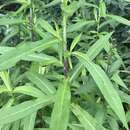fr
noms dans le fil d’Ariane


Several taxa have been recognized within this variable species. Here, we segregate Symphyotrichum firmum as a distinct entity. The tall, pink-rayed S. elliottii of the outer coastal plains is also distinctive, despite reports of hybrids with S. puniceum var. puniceum where their ranges overlap (see G. L. Nesom 1997b). A recently described member of the complex, S. rhiannon, is an ultramafic endemic from North Carolina. Here, within S. puniceum, we recognize two varieties, the variable and widespread var. puniceum, and var. scabricaule from the inner Gulf coastal plains, following Nesom, who also offered a useful summary of the infraspecific taxonomy of the species.
Symphyotrichum puniceum (formerly Aster puniceus), is a species of flowering plant in the family Asteraceae native to eastern North America. It is commonly known as purplestem aster,[3] red-stalk aster,[4] red-stemmed aster,[5] red-stem aster, and swamp aster.[6] It also has been called early purple aster, cocash, swanweed, and meadow scabish.[7]
Its range extends from the edges of the Great Plains to the Atlantic coast, and from the Gulf coast of Texas north to southern Ungava Bay in the north of Quebec.[3] It is adventive in Europe.[2]
Symphyotrichum puniceum produces flowers between August and October. The ray florets range from dark blue or purple to white (rarely). The disc florets are yellow to cream-colored, becoming pink or purple with maturity.[8]
Symphyotrichum puniceum is a variable species, and many forms have been named.[9] As of July 2021, Plants of the World Online (POWO) accepts one variety in addition to the autonym.[2] S. puniceum var. scabricaule (Shinners) G.L.Nesom occurs in the southern United States from Texas to Alabama.[10] The autonym, S. puniceum var. puniceum, occurs in most of the eastern United States and southern Canada.[11]
The species Symphyotrichum firmum is sometimes considered a variety of S. puniceum, but POWO and Flora of North America treat them as distinct species.[2][8] In 1999, Calvin College botanists David P. Warners and Daniel C. Laughlin gave evidence that they should be considered two distinct species.[12] Compared to S. firmum, Symphyotrichum puniceum is typically hairier, with purpler flowers, and does not form dense colonies but rather small clusters or scattered individuals.[13]
Symphyotrichum puniceum on left and S. firmum on right
Hybrids between this species and Symphyotrichum boreale have been recorded and are called Symphyotrichum × longulum.[14]
As of July 2021, NatureServe listed Symphyotrichum puniceum as Secure (G5) worldwide and Critically Imperiled (S1) in Mississippi.[1] It listed S. puniceum var. puniceum as Vulnerable (S3) in Kentucky,[15] and S. puniceum var. scabricaule as overall an Imperiled Variety (T2) and Critically Imperiled (S1) in Texas.[16]
Symphyotrichum puniceum has been used for medicinal purposes among indigenous people in North America. It has been documented that the Chippewa have smoked the root with tobacco to attract game.[17] Multiple uses have been reported for the Woodland Cree, including as an aid for tooth pain[18] and for healing a woman after childbirth.[19] The Iroquois have used the roots for healing of various ailments including colds,[20] fevers,[21] pneumonia,[22] typhoid,[23] and tuberculosis.[24]
Symphyotrichum puniceum (formerly Aster puniceus), is a species of flowering plant in the family Asteraceae native to eastern North America. It is commonly known as purplestem aster, red-stalk aster, red-stemmed aster, red-stem aster, and swamp aster. It also has been called early purple aster, cocash, swanweed, and meadow scabish.
Its range extends from the edges of the Great Plains to the Atlantic coast, and from the Gulf coast of Texas north to southern Ungava Bay in the north of Quebec. It is adventive in Europe.
Aster ponceau
Symphyotrichum puniceum, communément appelé Aster ponceau, est une espèce de plantes de la famille des Asteraceae.
Selon Tropicos (2 mars 2022)[2] (liste brute contenant possiblement des synonymes) :
La tige de cette plante de 1 à 2 m de hauteur est robuste et rougeâtre. Elle est munie de poils raides. Les entrenoeuds, c'est-à-dire la distance entre les points d'insertion des feuilles sur la tige, mesurent entre 10 et 60 cm. Ses feuilles sont alternes, simples, dentées et très rugueuses. Elles ne possèdent pas de queue et entourent plus ou moins la tige. Ses fleurs sont groupées en capitules bleu-violet[3].
L'aster ponceau peut être observé dans une variété d'habitats différents. On le trouve dans des lieux ouverts et plutôt humides, comme les clairières ou les taillis, les forêts subalpines, au bord de différents étandues d'eau (lacs, rivières, ruisseaux) ainsi que dans les fossés et les bords des routes[4]. On le trouve aussi dans les zones de marées des rivages estuariens[3].
L'aster ponceau est très bien adapté au climat québécois et supporte même nos plus grands froids. C'est pourquoi on le trouve donc dans toutes les régions du Québec et au Nord jusqu'au limite de la zone arctique[4]. On peut même le rencontrer dans l'Ungava[3].
Les Amérindiens utilisaient les petites ramifications des racines qu'ils mélangeaient au tabac[3].
Aster ponceau
Symphyotrichum puniceum, communément appelé Aster ponceau, est une espèce de plantes de la famille des Asteraceae.
Symphyotrichum puniceum là một loài thực vật có hoa trong họ Cúc. Loài này được (L.) Á.Löve & D.Löve miêu tả khoa học đầu tiên năm 1982.[1]
Symphyotrichum puniceum là một loài thực vật có hoa trong họ Cúc. Loài này được (L.) Á.Löve & D.Löve miêu tả khoa học đầu tiên năm 1982.